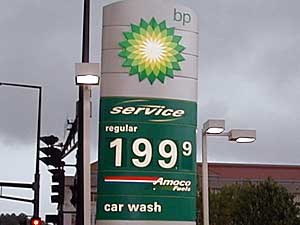|
Audio
Photos
Resources
Your Voice
|
Drivers feeling $2 a gallon gas pains
May 12, 2004
 |
| Is $2 gas here to stay? (MPR photo/Dan Olson) |
St. Paul, Minn. — If you think you're running up a fuel bill, consider Sandy Kiel's commute.
"We live in Lanesboro and I commute to the Twin Cities," says Kiel. "My husband commutes to the Twin Cities sometimes, and to the Rochester airport often."
The Kiels live in Lanesboro, 100 miles southeast of the Twin Cities. So, the Kiel family measures its monthly gasoline bill not in the tens, but in the hundreds of dollars, due in part to the fact, Sandy says, that one of their three children is still at home and is a high school athlete.
"The track meets are usually over one hour away, and there's one or two each week," says Kiel. "So I'm looking at somewhere between 50 and 100 miles a week for that."
 | |||
Before you start passing the hat for the Kiel family, it's worth noting their cumulative commuting mileage will drop soon. Sandy is taking a new job, will be working out of her Lanesboro area home, thereby lopping something approaching 500 miles a week off her driving.
On the other hand passing the hat may still be in order since the two Kiel family college daughters return home for the summer soon, thus activating two more of the family's total of five vehicles.
The Kiel family illustration is unusual, but not extreme. In Minnesota, as elsewhere, people often drive long distances for work or play.
For Melissa Wenzel, $2 a gallon gasoline is not good news. She's single and has a job, but is watching her budget because she's just out of college and has a batch of loans to repay. Wenzel says her neighbors are low-income families with children, and are hard-pressed to afford the higher pump prices.
"For them, I mean almost every penny counts. It's more important to feed your child than entertainment. And when you talk about transportation it's no longer a luxury for many people," she says. "There's been some discussion on what we can do to combine rides or carpool for various entertainment places when we do go out."
Costly as it is for some, $2 a gallon gas is not very expensive, according to David Levinson.
"Two dollars a gallon is still cheaper than the price of bottled water, and I don't think it'll affect people's behavior that much," Levinson says.
 | |||
Levinson is a University of Minnesota professor whose expertise includes transportation studies. He says the price rise, for example, will not cause many, if any, to turn to public transit in our region.
"Transit service is so bad for so many people that things would have to get very extreme ... for a large number of people to be willing to take transit in a place like the Twin Cities," he says.
Levinson says the changes caused by $2 a gallon gas will be too few and too small in the short term to cause a blip on the screen. The threshold of financial pain for most vehicle owners, he says, is higher.
"If you went to three dollars or four dollars or five dollars, you'd probably be able to measure the difference," he says.
Still, people who sell vehicles say they're noticing a difference. Toyota regional sales spokesman Dan Williams says more customers visiting their showrooms are taking a closer look at four and six-cylinder passenger vehicles, and walking past the eight-cylinder gas gulpers.
The most dramatic shift, Williams says, is to hybrids, the technology that marries the internal combustion engine with electricity to power a car. He says customers are waiting eight months to two years to buy the Toyota version. Williams says the hybrid vehicle market is expanding.
"(The customers are) not just technical people or niche marketing anymore ... it's appealing to just about everybody at this point," Williams says.
Hybrids account for less than 1 percent of the vehicles on U.S. roads. However, gas costs at $2 and above, and the prospect that prices won't decline much from that level, are driving more people to examine alternatives of all kinds.
As for the peripatetic Kiel family from Lanesboro, Sandy's advice for those concerned with $2 a gallon gasoline is get used to it.
"I guess I feel like it's our turn, and frankly we shouldn't be whining," she says. "If we got to figure it into the budget, then we got to figure it into the budget. Because everyone else around the rest of the world has done it for years."
|
News Headlines
|
Related Subjects
|
